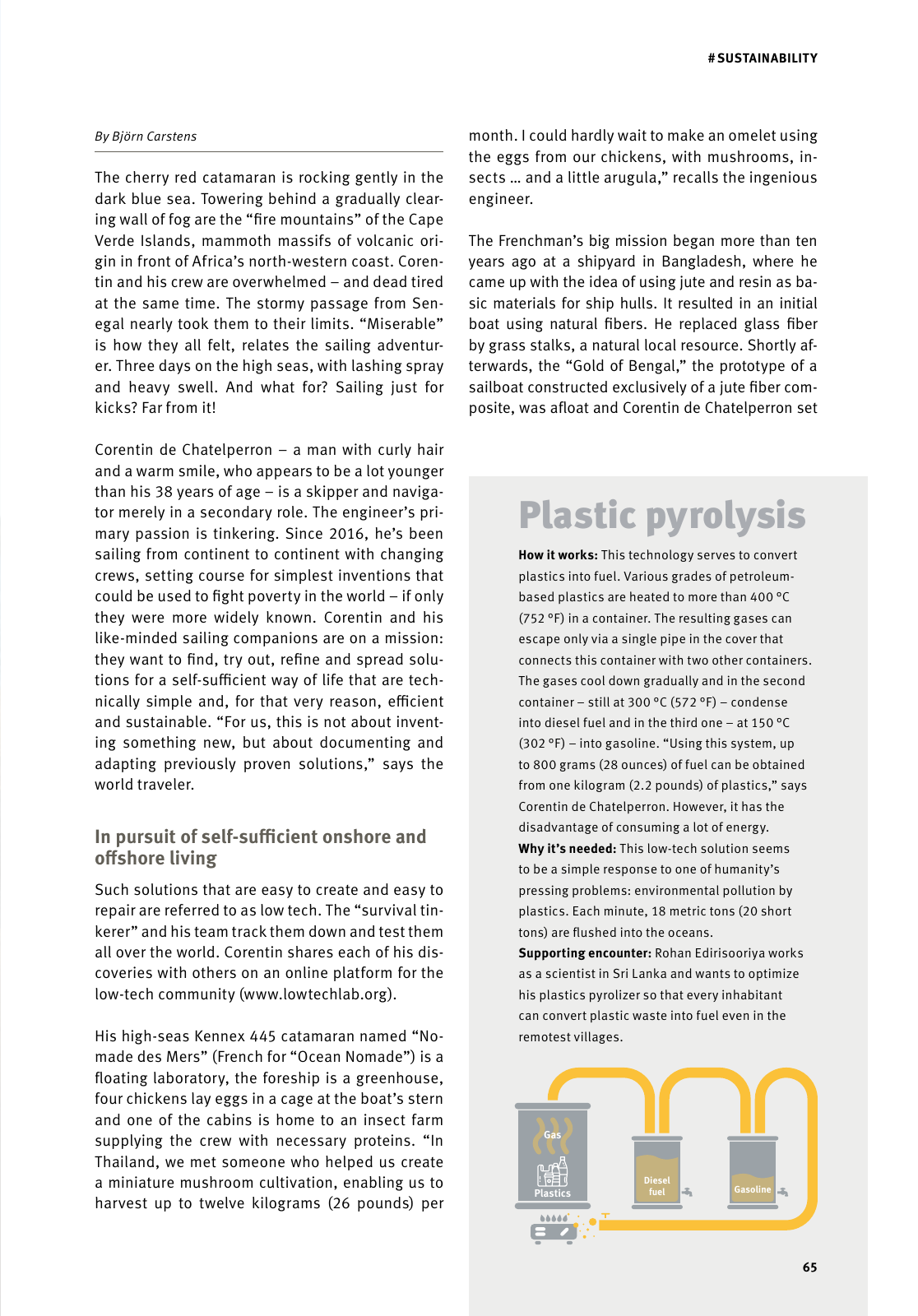Plastics Diesel fuel Gasoline Gas The cherry red catamaran is rocking gently in the dark blue sea Towering behind a gradually clear ing wall of fog are the fire mountains of the Cape Verde Islands mammoth massifs of volcanic ori gin in front of Africa s north western coast Coren tin and his crew are overwhelmed and dead tired at the same time The stormy passage from Sen egal nearly took them to their limits Miserable is how they all felt relates the sailing adventur er Three days on the high seas with lashing spray and heavy swell And what for Sailing just for kicks Far from it Corentin de Chatelperron a man with curly hair and a warm smile who appears to be a lot younger than his 38 years of age is a skipper and naviga tor merely in a secondary role The engineer s pri mary passion is tinkering Since 2016 he s been sailing from continent to continent with changing crews setting course for simplest inventions that could be used to fight poverty in the world if only they were more widely known Corentin and his like minded sailing companions are on a mission they want to find try out refine and spread solu tions for a self sufficient way of life that are tech nically simple and for that very reason efficient and sustainable For us this is not about invent ing something new but about documenting and adapting previously proven solutions says the world traveler In pursuit of self sufficient onshore and offshore living Such solutions that are easy to create and easy to repair are referred to as low tech The survival tin kerer and his team track them down and test them all over the world Corentin shares each of his dis coveries with others on an online platform for the low tech community www lowtechlab org His high seas Kennex 445 catamaran named No made des Mers French for Ocean Nomade is a floating laboratory the foreship is a greenhouse four chickens lay eggs in a cage at the boat s stern and one of the cabins is home to an insect farm supplying the crew with necessary proteins In Thailand we met someone who helped us create a miniature mushroom cultivation enabling us to harvest up to twelve kilograms 26 pounds per By Björn Carstens How it works This technology serves to convert plastics into fuel Various grades of petroleum based plastics are heated to more than 400 C 752 F in a container The resulting gases can escape only via a single pipe in the cover that connects this container with two other containers The gases cool down gradually and in the second container still at 300 C 572 F condense into diesel fuel and in the third one at 150 C 302 F into gasoline Using this system up to 800 grams 28 ounces of fuel can be obtained from one kilogram 2 2 pounds of plastics says Corentin de Chatelperron However it has the disadvantage of consuming a lot of energy Why it s needed This low tech solution seems to be a simple response to one of humanity s pressing problems environmental pollution by plastics Each minute 18 metric tons 20 short tons are flushed into the oceans Supporting encounter Rohan Edirisooriya works as a scientist in Sri Lanka and wants to optimize his plastics pyrolizer so that every inhabitant can convert plastic waste into fuel even in the remotest villages Plastic pyrolysis month I could hardly wait to make an omelet using the eggs from our chickens with mushrooms in sects and a little arugula recalls the ingenious engineer The Frenchman s big mission began more than ten years ago at a shipyard in Bangladesh where he came up with the idea of using jute and resin as ba sic materials for ship hulls It resulted in an initial boat using natural fibers He replaced glass fiber by grass stalks a natural local resource Shortly af terwards the Gold of Bengal the prototype of a sailboat constructed exclusively of a jute fiber com posite was afloat and Corentin de Chatelperron set 65 S U S TA I N A B I L I T Y

Hinweis: Dies ist eine maschinenlesbare No-Flash Ansicht.
Klicken Sie hier um zur Online-Version zu gelangen.
Klicken Sie hier um zur Online-Version zu gelangen.